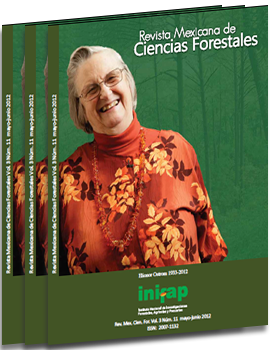APPLICATION OF THE CANADIAN FIRE WEATHER INDEX IN A NATIONAL PARK OF CENTRAL MEXICO
DOI:
https://doi.org/10.29298/rmcf.v3i11.515Keywords:
Early warning fires, natural protected areas, fuels moisture codes, FWI, fire potential index, forest fire preventionAbstract
Among the early warning systems there is one developed by the Canadian Forest Service, called the Fire Weather Index (FWI). To contribute in the creation of an early warning system this index was used to determine the fire danger conditions in Malinche National Park. Calculations of the elements contained in the FWI system were made using the automated version of the Canadian Forest Fire Danger Rating System applied to a series of daily data from January 2004 to October 2009 in five weather stations installed in the park at an altitude of 3,000 m. Four categories were created with the values of the correlation components according to fire frequency and damaged area. Maximum and minimum temperature, relative humidity and rain were identified. Minimum high fire danger thresholds were set for each one of the elements. In the case of Fine Fuel Moisture Code the maximum threshold was set at 80 points, if this value is exceeded the number of fires per day substantially increased. The Drought Code, the Initial Spread Index and Buildup Index, were most significant in relation to fire frequency. The probability of fires was calculated according to certain ranges of values of these components.
Downloads
Downloads
Published
How to Cite
Issue
Section
License
The authors who publish in Revista Mexicana de Ciencias Forestales accept the following conditions:
In accordance with copyright laws, Revista Mexicana de Ciencias Forestales recognizes and respects the authors’ moral right and ownership of property rights which will be transferred to the journal for dissemination in open access.
All the texts published by Revista Mexicana de Ciencias Forestales –with no exception– are distributed under a Creative Commons License Attribution-NonCommercial 4.0 International (CC BY-NC 4.0), which allows third parties to use the publication as long as the work’s authorship and its first publication in this journal are mentioned
The author(s) can enter into independent and additional contractual agreements for the nonexclusive distribution of the version of the article published in Revista Mexicana de Ciencias Forestales (for example, include it into an institutional repository or publish it in a book) as long as it is clearly and explicitly indicated that the work was published for the first time in Revista Mexicana de Ciencias Forestales.
For all the above, the authors shall send the form of Letter-transfer of Property Rights for the first publication duly filled in and signed by the author(s). This form must be sent as a PDF file to: ciencia.forestal2@inifap.gob.mx
This work is licensed under a Creative Commons Attribution-Noncommercial 4.0 International license.






